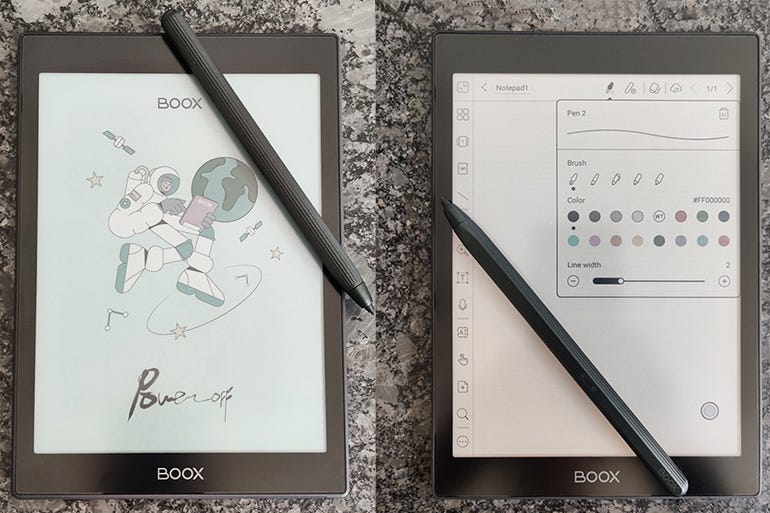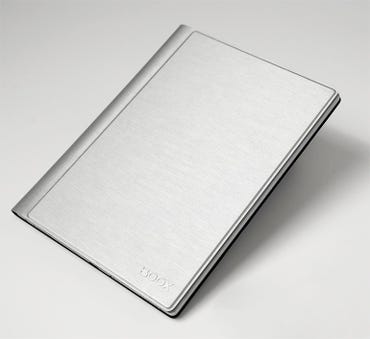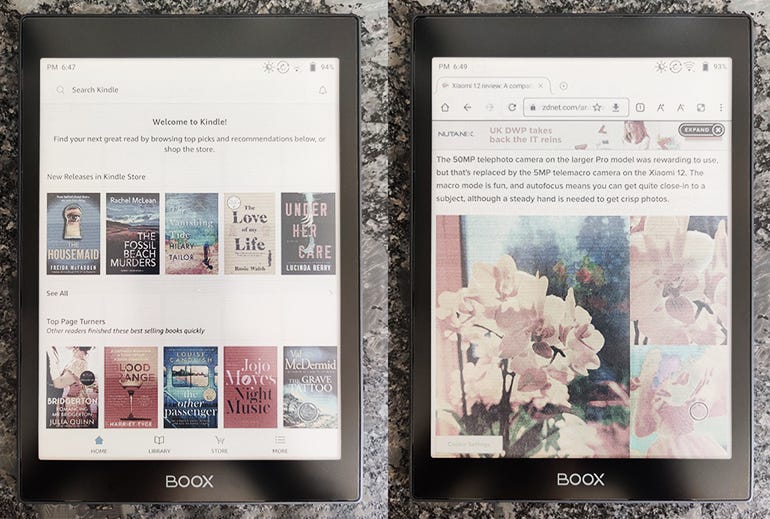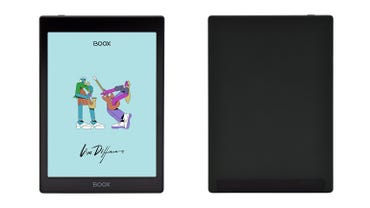Onyx Boox Nova Air C review: Android-based e-book reading, in colour | ZDNet
Images: Sandra Vogel / ZDNet

Onyx is an established maker of E Ink tablets that can accommodate pen input as well as run third-party applications, thanks to its implementation of Android. Onyx devices come in a range of sizes, for a range of use cases. I most recently looked at a pair of e-reader/content creation devices — the 13.3-inch Boox Max Lumi2 and 10.3-inch Boox Note Air2.
Now Onyx has adopted the E Ink Kaleido Plus colour screen, which offers 4,096 colours on a low-power panel. The 7.8-inch Onyx Boox Nova Air C couples this with Android 11 and stylus-based input. It promises 4 weeks of battery life in standby mode and costs $419.99/£399.99.
Like
- Colour E Ink screen
- Android 11 and Google Play Store
- Bundled stylus
- Good battery life
Don’t Like
- Cover is an optional extra
- No MicroSD card slot for storage expansion
Apart from the colour on its screen when the device is switched off, the Nova Air C looks like many other e-readers. It measures 136.5mm wide by 194mm deep by 6.3mm thick and weighs 235g without its optional cover ($59.99/£53.99). There’s a Boox marque along the bottom bezel, and just about enough side bezel to hold the device securely without touching the screen. The build feels robust, and there are no rough edges in terms of quality.
There’s just one button, on the top edge, which turns the device on and off. On the bottom edge there is a pair of speakers and a USB-C port for charging. The bezels lack any buttons or touch controls — you either tap the screen or use physical page-turn buttons on the optional case to get around.
The Nova Air C is powered by a Snapdragon 662 chipset with 3GB of RAM and 32GB of internal storage. There’s no MicroSD card slot to augment the storage, which arguably is a problem given the potential for this device to unite all your e-books and audio books, as well as functioning to some degree as a productivity tool thanks to its support for pen-based input.
For connectivity there’s Wi-Fi 5 (802.11ac) and Bluetooth 5.0, so earbuds can be paired if the internal speakers are too intrusive for your location. I found the speakers to deliver good quality audio for listening to material such as podcasts. The USB-C port is used for charging, and can also be used to connect the Nova Air C to your computer, when it becomes available for drag-and-drop file transfer.
The Nova Air C’s 2,000mAh battery will last for four weeks on standby, according to Onyx. Given that E Ink screens take power only when they refresh, power consumption is lower than on regular tablets, phones or laptops. During testing I regularly got a week of e-book reading between charges, although I was careful to turn Wi-Fi off whenever it wasn’t needed, to help conserve the battery. There’s no fast charging here, so you need to keep an eye on the power level and ensure there’s enough time for a boost when it gets low.

The cover for the Boox Nova Air C is an optional extra costing $59.99 or £53.99.
Image: Onyx
It is unfortunate that the device cover has to be purchased separately, at a rather hefty $59.99/£53.99. Buy it and you’ll have a total outlay of $479.98/£453.98. I’m not a fan of the case’s silver colouring, but the magnets that secure it to the Nova Air C are strong. You could search the web for suitable alternative protection if budget is tight, and will only miss out on a pair of physical page-turn buttons.
Fortunately, the stylus that’s needed to make the most of the Nova Air C is provided with the device itself. It attaches to the right side of the reader via magnets, and while the grip is fairly strong it’s not secure enough to be a permanent solution. The case doesn’t have a loop or slot to hold the stylus, which meant that whenever I took the Nova Air C anywhere I was likely to need the stylus, I had to remember to carry it. Long term, this would likely be an issue for me. A more reliable solution is needed, even if that means adjusting the design of the stylus or tablet to accommodate an on-device housing.
The 7.8-inch screen delivers two different pixel densities thanks to the way that the Kaleido Plus display works. In colour mode the resolution is 468 by 624 pixels, delivering a pixel density of 100dpi, while in monochrome mode this rises to 1,404 by 1,872 pixels and a pixel density of 300dpi.
Onyx says Kaleido Plus provides 30% improved contrast in mono mode in comparison to its predecessor, as well as 30% improved contrast in colour mode and 15% colour enhancement. These improvements come because touch response is now incorporated within the screen itself rather than requiring a separate layer on top of the display which, inevitably, is a visual barrier to the display itself. E Ink calls this capability ‘on-cell’.
Without two devices side by side it’s hard to evaluate these claims in real-world use, but my everyday experience was positive. I found e-book reading entirely satisfactory, and page turns to be just as fast and clean as I’d expect from any e-reader device. The 7.8-inch screen size is good too — just around the sweet spot for reading. I downloaded both the Kindle and Kobo reader apps, as well as the Libby app used by my public library. All worked well. There are plenty of fonts and sizes to select between, and the device supports a range of document formats: PDF (reflowable), PPT, EPUB, TXT, DJVU, HTML, RTF, FB2, DOC, MOBI, CHM. It also supports PNG, JPG, TIFF, BMP images, WAV and MP3 audio, and DRM via third-party apps.

Colour — but not as you know it on a tablet with a backlit LCD or OLED screen.
Images: Sandra Vogel / ZDNet

The colour screen meant I found myself enjoying magazines via my public library lending service as much as reading e-book loans. That said, the E Ink Kaleido Plus screen is nowhere near as good at colour rendering as a regular tablet or phone. Don’t set your expectations that high.
Android 11 provides access to the e-reading apps I installed, as well as to the rest of Google’s Play Store. Alongside this are some pre-installed Onyx apps such as a dictionary and the NeoBrowser web browser, a Boox ebook store, and a note-taking app that allows you to create and save hand-written notes using the stylus. The stylus has 4,096 levels of pressure sensitivity, and there are plenty of brushes, line widths and colour choices to work with.
Handwriting-to-text conversion is supported, and I found this to be pretty accurate. You can also record spoken word content — the microphone is on the bottom edge — and the resulting audio can be embedded in a document.
To help users get around the relative complexities of what’s on offer, a small circle can be set to be always present on-screen, and tapping this calls up nine shortcut buttons, which can be customised to specific functions such as application launches. Even so, the user interface is different from that on any other device, and there are so many capabilities and settings options, that it will take a little while before the full rage is explored. This isn’t a criticism — it just highlights what a well-featured device this is.
Conclusions
The Onyx Boox Nova Air C is an interesting mix of e-book reader, content creation device and tablet, with Android 11 making a wide range of apps available. It’s well made, has long battery life and comes with a bundled stylus.
The absence of a MicroSD card slot to boost the 32GB of internal storage is disappointing. The colour E Ink display is not as vibrant as that of a regular tablet or phone, and screen refreshes are slow in comparison. The Nova Air C is in no way a substitute for either device, but the addition of a colour display brings a welcome new dimension to the Onyx Boox range, which should pleas fans of its hybrid content consumption/creation approach.
Onyx Boox Nova Air C specifications
|
Display |
E Ink Kaleido Plus, 7.8 inches, 4096 colors, touch (inductive Wacom + capacitive), 1872 x 1404 (300ppi/100 ppi in color mode), SNOW Field function |
|
Front light |
MOON Light 2 |
|
Processor |
Qualcomm Snapdragon 662 Mobile Platform |
|
RAM |
3GB |
|
Storage |
32GB |
|
Audio |
speaker, microphone |
|
Wired connection |
USB Type-C |
|
Supported file formats |
TXT, HTML, RTF, FB2, FB2.zip, DOC, DOCX, PRC, MOBI, CHM, EPUB, JPG, PNG, GIF, BMP, PDF, DjVu, MP3, WAV, CBR, CBZ |
|
Wi-Fi |
Wi-Fi 5 (802.11ac) |
|
Bluetooth |
5 |
|
Battery |
2000mAh lithium polymer |
|
Operating system |
Android 11 |
|
Dimensions |
136.5mm × 194mm × 6.3mm |
|
Colour |
black |
|
Weight |
235g |
|
In the box |
Onyx Boox Nova Air C, user manual, stylus, USB cable, warranty card |
|
Price |
$419.99 / £399.99 |
Alternatives to consider
Low-power, backlight-free technologies for colour e-book readers are a developing field. For example, E Ink is exploring a technology called Advanced Color ePaper (ACeP), although this is currently only available as a $799 evaluation kit, and in April launched a successor to Kaleido Plus called Kaleido 3. Another promising but as-yet unfulfilled development is TCL’s NXTpaper Mid, which uses a transflective LCD. An E Ink-alternative technology that has made it to market is DES (Display Electronic Slurry), as seen in the Reinkstone R1.
RECENT AND RELATED CONTENT
Onyx Boox Max Lumi2 & Note Air2, hands on: Capable E Ink tablets for content consumption and creation
Amazon Kindle Paperwhite (2021) review: A classic, now modern, e-reader thanks to USB-C and wireless charging
Kobo Elipsa review: A versatile E-Ink ebook reader and notetaker
Lenovo’s ThinkBook Plus melds the best of ThinkPad and E Ink pad
The best e-readers: Kindle, Kobo, and more
Read more reviews
For all the latest Technology News Click Here
For the latest news and updates, follow us on Google News.

